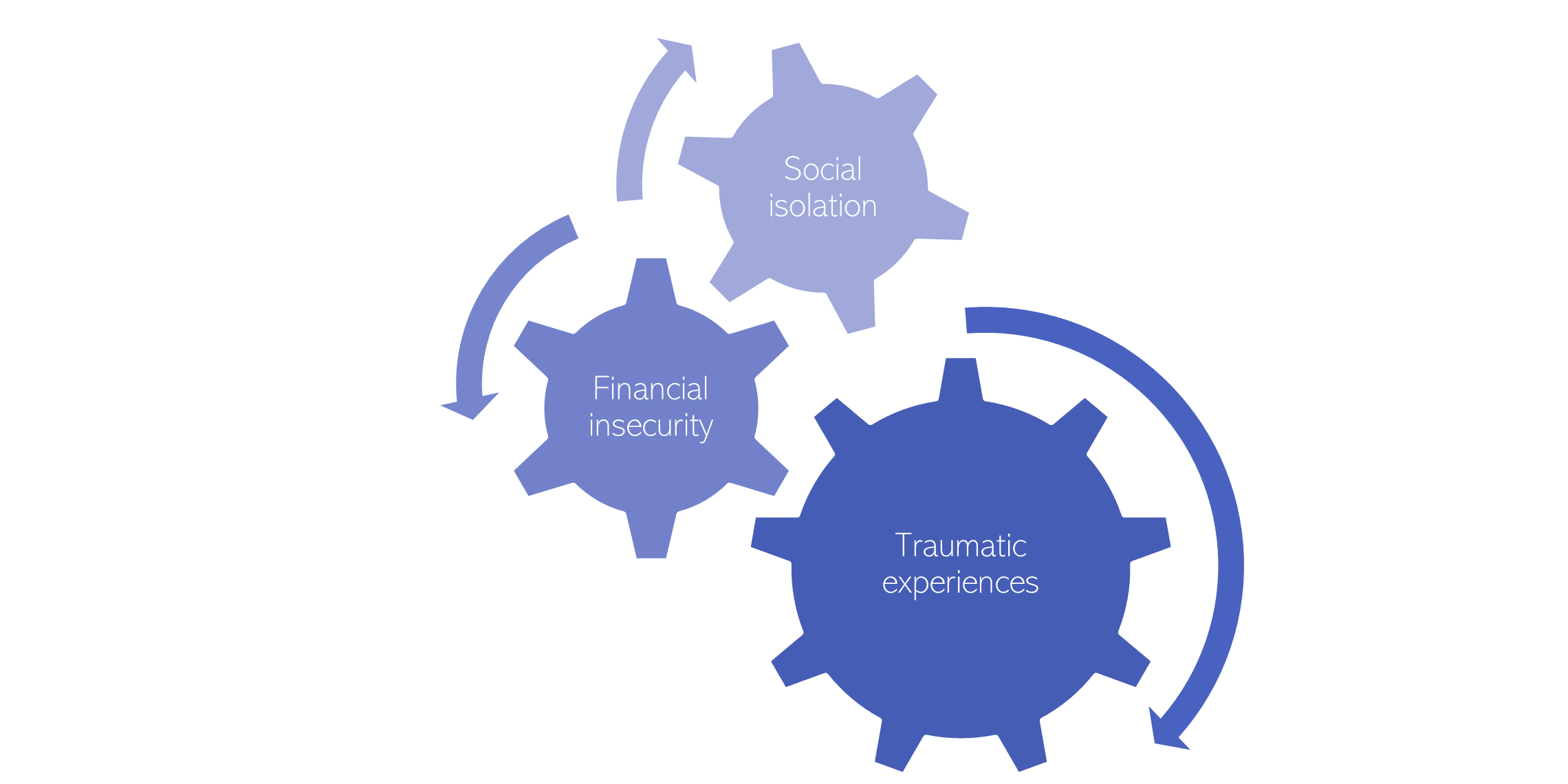Refugees and asylum seekers
Note on terminology: in the UK, people seeking refuge fall under two legal labels, ‘asylum seekers’ and ‘refugees’. Asylum seekers are people who have applied for asylum under the 1951 Convention Relating to the Status of Refugees; whilst refugees have had their asylum claim accepted (Mind, 2009). The category asylum seeker therefore includes people who may later be recognised as refugees, some whose claims will be refused, and others who are given a different form of resident permit (Mind, 2009). Within refugees and asylum seekers populations, there is a wide range of diversity in terms of culture, ethnicity, religion, trauma exposure and resettlement experiences (Vostanis, 2014).
- Adult refugees are more likely have post-traumatic stress disorder (PTSD), depression and anxiety than the general population (Vostanis, 2014), as well as to have experienced traumatic events (Vostanis, 2014).
- A 2009 survey of asylum-seeking women found that (Zimmerman et al., 2009):
- 57% met criteria for PTSD.
- 20% reported having suicidal thoughts in the past week.
- 22% had attempted suicide.
- Traumatic experiences such as fleeing from war and living in refugee camps can have long-term impacts on the mental health of young people (Lustig et al., 2004). There are high rates of PTSD in young refugees, and comorbidity with conditions such as depression is common (Lustig et al., 2004).
- Refugee children also report higher levels of self-harm, suicidal ideation and problems with sleeping and eating (Khan, 2016).
- Victims of torture, children, women and LGBTQ+ asylum seekers are at a particularly high risk of experiencing mental health conditions (Aspinall & Watters, 2010).
Risk factors for poor mental health
Key risk factors for poor mental health amongst refugee and asylum seeker populations include traumatic experiences, social isolation and financial insecurity.

Figure 46: Factors contributing to poor mental health in refugee and asylum seeker populations
- An estimated 5 to 30% of people seeking asylum have survived torture (Aspinall & Watters, 2010).
- Financial hardship and a lack of social support are both associated with common mental health conditions amongst people seeking asylum (Pollard & Howard, 2021; Sengoelge et al., 2020).
- Exposure to violence is a risk factor for poor mental health in refugee children; whilst stable settlement and social support from family and friends can have a protective effect (Fazel et al., 2012).
- Experiences of complex trauma and poor mental health faced by refugees and people seeking asylum can be compounded by homelessness (Boobis et al., 2019).
- The uncertainty of living with a No Resource to Public Funds (NRPF) condition has detrimental impacts on mental health and is associated with anxiety and depression (Jolly et al., 2022). People who have NRFT are ineligible for the majority of support services (Refugee Council, 2021).
Access
Refugees and people seeking asylum face multiple barriers to accessing mental health care (Pollard & Howard, 2021). National research highlights the following barriers:
Structural barriers to accessing mental health support
-
- Having their phones confiscated at the border under the immigration powers, and thus being unable to access digital services (Refugee Council, 2021).
- Many individuals with severe and enduring mental health conditions are detained in immigration detention centres (Mind, 2009). However, there is a lack of specialist mental healthcare in these centres (Aspinall & Watters, 2010).
- People who have been refused asylum are not entitled to free secondary care and are therefore unable to access many mental health services (Mind, 2009).
- People with experience of seeking asylum highlight that the cost of public transport prevents them from being able to travel to appointments (British Red Cross, 2022).
Healthcare system barriers to accessing mental health support
-
- Some people seeking asylum are mistakenly being refused GP registration (Refugee Council, 2021)
- People with experience of seeking asylum report that a lack of interpreter services could prevent them from being able to access healthcare (British Red Cross, 2022).
- There is a lack of mental health services aimed at asylum seeking and refugee children, young people and their families (Mind, 2009).
- Pathways into secondary mental health services often fail to account for the specific needs of refugees (Mind, 2009).
- There is a lack of accessible drug and alcohol services for asylum seekers and refugees who experience homelessness (Boobis et al., 2019).
- Some people may experience language barriers.
Individual barriers to accessing mental health support
-
- Many people lack trust in the healthcare system, and fear that their medical data will be shared with the Home Office (Refugee Council, 2021).
Little data is collected on the use of secondary healthcare by people seeking asylum and refugees, or on the services accessible to vulnerable groups such as disabled people seeking asylum (Aspinall & Watters, 2010).
Experience
National research states that there is limited use of interpreters within mainstream mental health services, and as a result, people often have to rely on friends and family to provide interpretations (Mind, 2009). Culturally appropriate mental health support for refugees and people seeking asylum is limited (Mind, 2009).
Outcomes
In immigration detention centres ‘people simply deteriorate – suicide attempts and sectioning are common. The stress of being in a chaotic environment with the constant threat of deportation for many months is devastating for people with pre-existing vulnerabilities’ (Mind, 2009).
Additional resources
- The local data pack gives an overview of key data and trends
- The mental health of asylum seekers and refugees in the UK
- Refugees and asylum seekers A review from an equality and human rights perspective
- Mind’s report A civilised society: Mental health provision for refugees and asylum-seekers in England and Wales
- National Institute of Health Research’s summary of the importance of displacement within public mental health
- Language interpreting and translation: migrant health guide
- Migrant and Refugee Joint Strategic Needs Assessment for Cambridgeshire, 2016
References
Full list of references is included at the end of this chapter.
